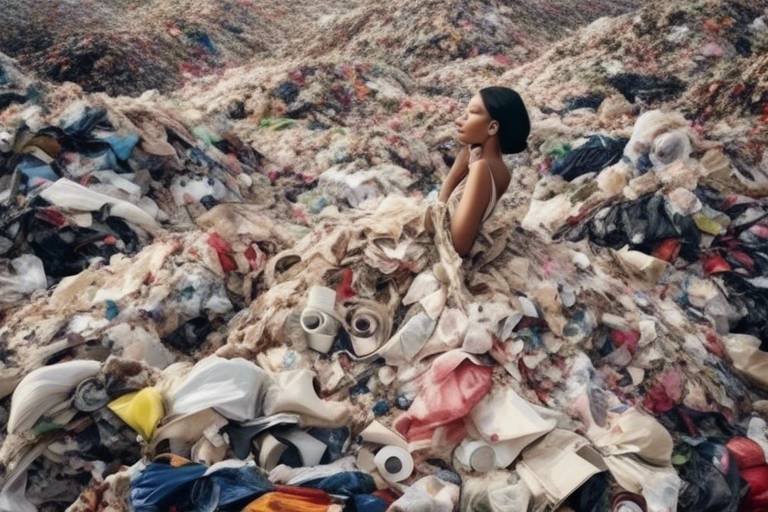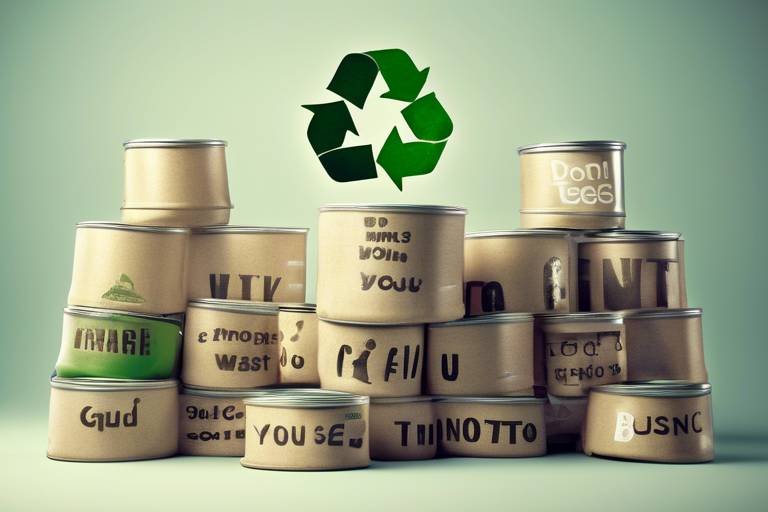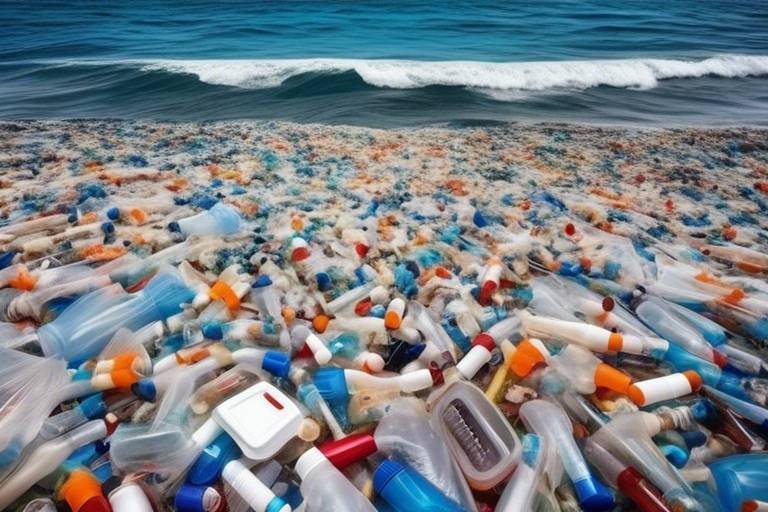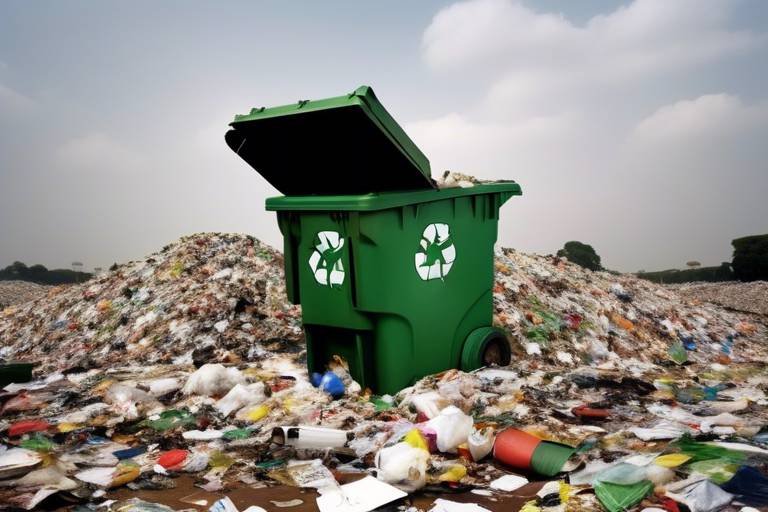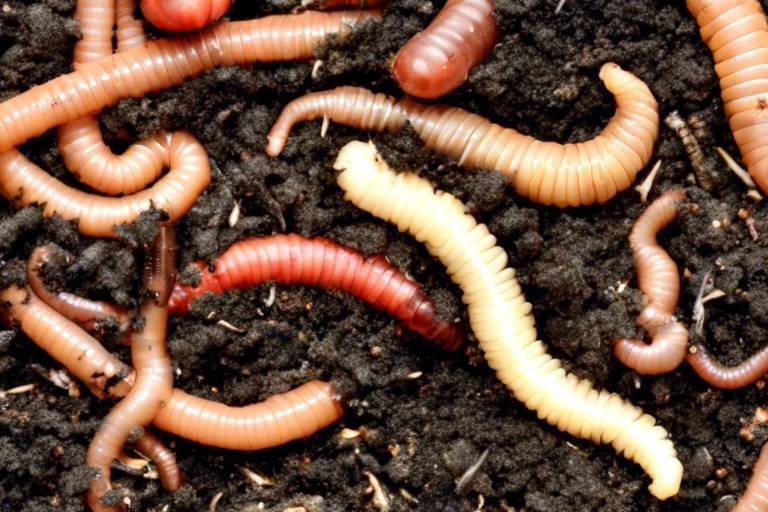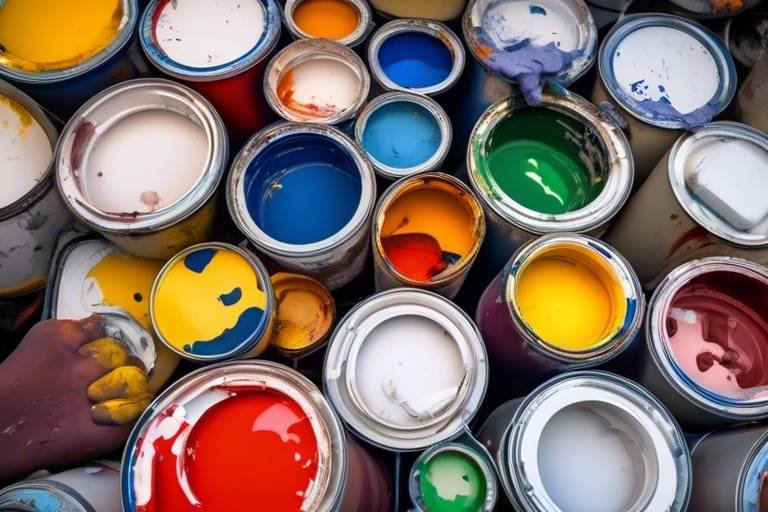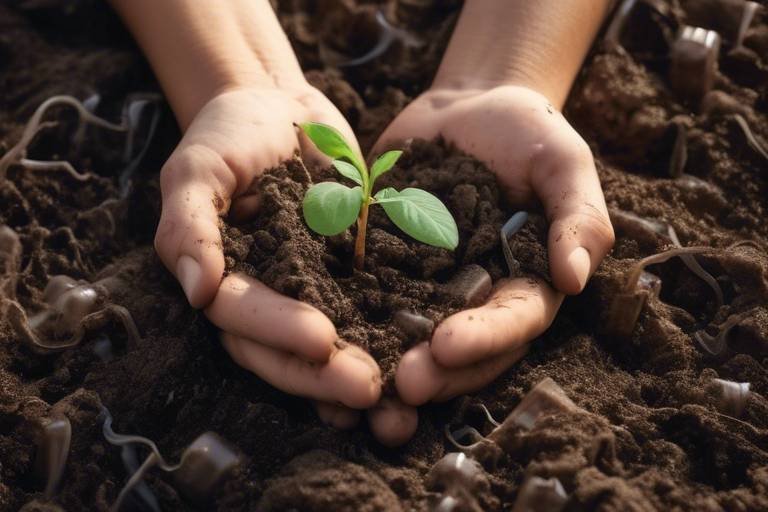Creative Ways to Reuse Packaging Materials
In a world where sustainability is becoming increasingly important, finding innovative ways to reuse packaging materials is not just a trend—it's a necessity. This article explores practical methods to repurpose everyday packaging items, turning them into valuable resources for your home and community. By embracing creativity, we can significantly reduce waste and contribute to a healthier planet. So, why not dive in and discover how those seemingly useless boxes and containers can transform into something extraordinary?
Cardboard boxes are often seen as mere trash after their initial purpose is served. However, with a little imagination, they can be transformed into a variety of useful items. For instance, you can create storage solutions by stacking and decorating boxes to fit your style. Need a unique coffee table? Why not glue several boxes together, cover them with fabric, and voilà! You've got a chic piece of furniture. The possibilities are endless, and each project not only beautifies your space but also minimizes waste.
Plastic containers are everywhere, from food storage to packaging. But did you know they can be turned into practical items beyond their original use? With a bit of creativity, you can transform these containers into planters, organizers, or even art projects. Imagine using an old yogurt container as a stylish herb planter on your kitchen windowsill. Not only does this reduce plastic waste, but it also adds a touch of green to your home. Let's explore some specific ideas!
Transforming plastic containers into planters is an excellent way to help the environment while adding beauty to your space. You can use containers of various sizes, from large buckets to small jars. To create a unique planter, consider the following tips:
- Choose a container with drainage holes or create your own by poking holes in the bottom.
- Paint or decorate the outside to match your decor.
- Fill with potting soil and your favorite herbs or flowers.
By giving plastic a second life as a planter, you're not only beautifying your home but also contributing to a sustainable future.
Using plastic containers for herb gardens is a sustainable way to grow your own herbs right at home. Whether you have a sunny windowsill or a small balcony, you can easily create an indoor or outdoor herb garden using repurposed materials. Start by collecting various containers like old coffee cans, plastic bottles, or even egg cartons. Fill them with soil, plant your herbs, and watch them flourish. Having fresh herbs at your fingertips not only enhances your cooking but also promotes a greener lifestyle!
Glass jars are perfect for organization and storage, and they can be repurposed in countless ways. From kitchen storage to craft supplies, these jars can help you declutter and beautify your space. You can paint the lids, label them, or even use them as decorative accents. For example, fill a jar with colorful buttons or seashells and place it on your shelf as a lovely display. The versatility of glass jars makes them a go-to for anyone looking to organize their home.
Packaging materials can serve as a fantastic source of inspiration for various craft projects. From scrapbooking to home decor, you can utilize these materials in fun and artistic ways. Consider creating greeting cards from old packaging or using bubble wrap to make textured paintings. The only limit is your imagination! Not only do you get to express your creativity, but you also contribute to reducing waste.
When it comes to gift-giving, why not make it eco-friendly? Using packaging materials for gift wrapping is a creative way to reduce waste while adding a personal touch. You can wrap gifts in recycled paper, fabric scraps, or even newspaper. Add some twine or dried flowers for an extra special touch. Your friends and family will appreciate the thoughtfulness and sustainability behind your gift wrapping choices.
Old packaging can be transformed into reusable shopping bags, which is a fantastic way to promote sustainability while shopping. You can sew or craft bags from materials like fabric scraps or sturdy paper. Not only do these bags reduce plastic waste, but they also add a unique flair to your shopping experience. Imagine walking into a store with a bag that you made yourself—it's a great conversation starter!
Don’t forget about your furry friends! Packaging materials can also be repurposed for pet projects. From creating toys to building beds, there are numerous ways to ensure your pets have fun while being eco-friendly. For example, you can use cardboard boxes to create a cozy hideaway for your cat or fashion a tug toy from old fabric scraps for your dog. It’s a win-win situation!
Q: What are some easy projects for beginners?
A: Start with simple projects like creating planters from plastic containers or using glass jars for organization. These projects require minimal skills and have a big impact!
Q: How can I get my kids involved in reusing packaging materials?
A: Kids love crafts! Encourage them to create art projects using cardboard boxes or plastic containers. It's a fun way to teach them about sustainability while sparking their creativity!
Q: Are there any safety concerns when repurposing packaging materials?
A: Always ensure that any materials you use are clean and safe. For example, if you're using food containers, make sure they are thoroughly washed. If you're crafting something for pets, avoid materials that could be harmful if ingested.

1. Upcycling Cardboard Boxes
Cardboard boxes are often seen as mere containers, but they hold a treasure trove of possibilities just waiting to be unleashed. Instead of tossing them into the recycling bin, why not consider the exciting world of upcycling? This creative process not only enhances your living space but also contributes to a more sustainable lifestyle. Imagine transforming that old shipping box into a stylish storage solution or a unique piece of furniture that tells a story. The best part? It’s easier than you might think!
One fantastic way to start is by turning your cardboard boxes into storage solutions. You can easily cut and fold boxes to create drawer organizers, perfect for keeping your desk tidy or your craft supplies in check. With a bit of paint or decorative paper, these boxes can become chic organizers that blend seamlessly with your home decor. Not only does this method clear up clutter, but it also adds a personal touch to your space.
But why stop there? Cardboard can also be transformed into decorative items. Consider crafting wall art by cutting shapes from cardboard and painting them in vibrant colors. You could even create a gallery wall that reflects your personality, using a mix of textures and designs. Additionally, cardboard can be repurposed into functional furniture pieces. For example, a sturdy box can be reimagined as a coffee table or a stool with just a few modifications. The possibilities are endless!
Here are a few creative ideas to get your imagination flowing:
- Cardboard Shelves: Stack and secure boxes to create floating shelves for books or plants.
- Kids' Playhouse: Transform large boxes into a fun playhouse for children, encouraging imaginative play.
- Gift Boxes: Decorate boxes to create unique gift boxes that add a personal touch to your presents.
In addition to being a fun DIY project, upcycling cardboard boxes is a great way to teach children about sustainability. Involving kids in these projects can spark their creativity while instilling the importance of reducing waste. It’s a win-win situation!
Lastly, if you’re feeling particularly adventurous, consider hosting a cardboard crafting party with friends and family. Gather all those unused boxes and challenge each other to create something fabulous. Not only will you have a blast, but you’ll also produce some amazing upcycled treasures. Who knew that a simple cardboard box could lead to so much creativity and fun?
In conclusion, upcycling cardboard boxes is a practical and enjoyable way to enhance your home while promoting sustainability. So the next time you receive a package, think twice before throwing that box away. Instead, embrace your inner artist and let your imagination run wild!

2. Repurposing Plastic Containers
Plastic containers are often seen as mere trash after their original purpose has been fulfilled. However, if you take a moment to think creatively, these items can be transformed into versatile tools that serve a variety of functions in your home and garden. From organizing your space to creating unique decor, the possibilities are endless. Why toss them out when you can give them a second life? Let’s dive into some innovative ways to repurpose those plastic containers that might otherwise end up in a landfill.
One of the most popular uses for plastic containers is as planters. Imagine turning a simple yogurt cup or a large detergent bottle into a vibrant home for your favorite herbs or flowers. With just a few holes for drainage and some soil, you can create a mini garden that not only beautifies your space but also helps the environment by reducing plastic waste. For those of you who love to cook, having fresh herbs at your fingertips is a game changer. Plus, it’s a fun project to do with kids, teaching them the value of recycling while nurturing their green thumbs.
To get started with your own plastic planters, here are a few tips:
- Choose the Right Container: Opt for containers that are sturdy and have a wide opening. Items like milk jugs, soda bottles, and large food containers work well.
- Prep the Container: Clean the container thoroughly and poke holes in the bottom for drainage. This is crucial to prevent overwatering.
- Fill with Soil: Use high-quality potting soil and consider adding some compost to enrich the mix.
- Plant Your Seeds or Seedlings: Follow the planting instructions specific to the herbs or flowers you choose.
But that’s not all! Plastic containers can also serve as organizers around the house. Think about your cluttered kitchen drawers or messy craft supplies. With a little creativity, you can turn those containers into stylish organizers. For instance, small containers can hold spices, while larger ones can be used to store craft supplies or office materials. Personalizing these organizers with paint or decorative paper can add a touch of flair to your space.
Another exciting avenue is to use plastic containers for art projects. Let your imagination run wild! You can cut and reshape these containers to create everything from bird feeders to unique sculptures. This not only keeps your hands busy but also inspires a sense of accomplishment as you see your creations come to life. It’s a fantastic way to engage with your kids, teaching them about sustainability while fostering their artistic skills.
In summary, repurposing plastic containers is not just about reducing waste; it's about unleashing your creativity. Whether you’re growing your own herbs, organizing your home, or crafting unique art pieces, these containers can play a vital role in your eco-friendly journey. So, the next time you finish a container, think twice before tossing it in the recycling bin. With a little bit of effort and imagination, you can transform it into something truly special!
Q: What types of plastic containers are best for planting?
A: Look for containers that are made from food-grade plastics, such as yogurt cups or milk jugs, as they are safe for growing plants. Ensure they have drainage holes for optimal plant health.
Q: Can I paint plastic containers for decoration?
A: Yes! Use acrylic paint or spray paint designed for plastic. Just make sure to clean the surface well before applying the paint to ensure it adheres properly.
Q: Are there any safety concerns with repurposing plastic containers?
A: Always check the type of plastic. Avoid using containers that previously held chemicals or non-food items for planting or food storage.
Q: How can I ensure my repurposed containers are eco-friendly?
A: Focus on reusing containers as much as possible, and when they do reach the end of their life cycle, recycle them properly according to your local recycling guidelines.

3. Creative Planters from Plastic
Transforming plastic containers into planters is not just a fun project; it's a fantastic way to contribute to environmental sustainability. Imagine all those plastic bottles, yogurt containers, and takeout boxes that often end up in landfills. Instead of tossing them out, why not give them a second life as vibrant planters? This not only reduces plastic waste but also allows you to add some greenery to your living space. Plus, the satisfaction of creating something beautiful from something that would otherwise be discarded is truly rewarding!
To get started, you'll need some basic tools and materials. The beauty of using plastic containers is their versatility. Here’s a quick rundown of what you might need:
- Plastic containers (bottles, jars, or food containers)
- Scissors or a craft knife
- Potting soil
- Seeds or small plants
- Paint or decorative materials (optional)
Once you've gathered your materials, the process is simple. Start by cleaning your plastic containers thoroughly to ensure no leftover food or chemicals are present. Next, use scissors or a craft knife to cut drainage holes in the bottom of each container. This is crucial because it prevents water from accumulating, which can lead to root rot. After that, fill your containers with potting soil, leaving some space at the top for your plants.
Now comes the fun part—planting! You can choose to grow herbs, flowers, or even small vegetables, depending on your interests and available sunlight. For instance, if you love cooking, why not plant some basil or cilantro? They thrive in smaller containers and add a fresh touch to your dishes.
Once you've planted your seeds or small plants, consider personalizing your planters. You can paint them in bright colors, or wrap them in twine for a rustic look. Not only does this enhance your home decor, but it also makes for great conversation starters when guests come over. Imagine someone asking where you got that unique planter, and you get to say, “Oh, that’s just an old plastic bottle!”
Moreover, if you’re feeling particularly crafty, you can create themed planters. For example, you might want to create a mini herb garden using various plastic containers, each labeled with the herb it contains. This not only keeps your garden organized but also adds a touch of creativity to your kitchen or balcony.
In conclusion, turning plastic containers into planters is a simple yet impactful way to promote sustainability. It allows you to express your creativity while also doing your part to reduce waste. So, the next time you finish a bottle of soda or a container of yogurt, think twice before tossing it in the recycling bin. With just a little effort, you can create something beautiful that brings life to your home!
1. Can I use any type of plastic container for planters?
Yes, most plastic containers can be used for planters, but it's best to avoid those that previously contained harmful chemicals. Always clean them thoroughly before use.
2. How do I ensure proper drainage in my plastic planters?
Make sure to cut several drainage holes in the bottom of your containers. This will help prevent water from accumulating and causing root rot.
3. What plants are best for small plastic planters?
Herbs like basil, mint, and cilantro are excellent choices for small planters. They require less space and can thrive in smaller environments.
4. Can I decorate my plastic planters?
Absolutely! You can paint them, wrap them in twine, or use stickers to personalize your planters and make them fit your home decor.

4. DIY Herb Gardens
Creating your own DIY herb garden using repurposed plastic containers is not only a sustainable choice but also a rewarding hobby that can enhance your cooking and living space. Imagine stepping into your kitchen and snipping fresh basil or mint right from your own garden; it’s like having a mini grocery store at your fingertips! This project is perfect for those who want to embrace sustainability while enjoying the benefits of home-grown herbs.
To get started, gather some plastic containers that you no longer use. Think about old yogurt cups, takeout containers, or even large soda bottles. Make sure to clean them thoroughly and, if necessary, drill a few holes in the bottom for drainage. This step is crucial because plants need to breathe, and excess water should be able to escape to prevent root rot. You can also paint or decorate these containers to match your kitchen decor, adding a personal touch and making them visually appealing.
Next, choose your favorite herbs to plant. Some popular options include:
- Basil - Great for Italian dishes and pesto.
- Parsley - A versatile herb that enhances many recipes.
- Cilantro - Perfect for salsa and Asian cuisines.
- Mint - Refreshing for teas, desserts, and cocktails.
Once you have your containers ready and herbs selected, fill each container with potting soil, leaving about an inch of space at the top. Gently press the soil down and make small holes for planting your herbs. Place the seeds or small plants into the holes and cover them lightly with soil. Water them gently, ensuring the soil is moist but not saturated. It’s important to place your containers in a spot that gets plenty of sunlight, ideally 6-8 hours a day, as most herbs thrive in bright conditions.
As your herbs grow, remember to maintain them by watering them regularly and trimming them back to encourage bushy growth. Not only will this keep your plants healthy, but it will also provide you with fresh herbs to enhance your meals. Plus, it’s a fantastic way to teach kids about gardening and sustainability!
Incorporating DIY herb gardens into your home is a simple yet impactful way to reduce waste while enjoying the fruits of your labor. So, grab those old plastic containers and get started on your journey to a greener, more flavorful kitchen!
Q: What types of herbs are easiest to grow in containers?
A: Herbs like basil, parsley, cilantro, and mint are generally easy to grow in containers due to their adaptability and low maintenance needs.
Q: How often should I water my herb garden?
A: It's best to water your herbs when the top inch of soil feels dry. Overwatering can lead to root rot, so ensure good drainage in your containers.
Q: Can I grow herbs indoors?
A: Absolutely! Many herbs thrive indoors as long as they receive enough sunlight. A south-facing window is ideal for indoor herb gardens.
Q: Do I need to fertilize my herbs?
A: While herbs can grow in regular potting soil, using a balanced, water-soluble fertilizer every few weeks can promote healthier growth.

5. Organizing with Jars
When it comes to organization, glass jars are like the unsung heroes of the home. They are not just for storing food; they can be transformed into stylish and functional storage solutions for nearly every room in your house. Imagine walking into your kitchen and seeing all your spices neatly arranged in labeled jars, or your craft supplies beautifully displayed in clear containers. It’s not just about aesthetics; it’s about maximizing space and minimizing clutter.
One of the best things about using jars for organization is their versatility. You can use them in the kitchen for storing dry goods like pasta, rice, or even snacks. In the bathroom, they can hold cotton balls, swabs, or even homemade scrubs. The living room can benefit from jars that store remote controls, batteries, or even small toys. The possibilities are endless!
To get started, you might want to consider the following tips:
- Labeling: Use chalkboard labels or washi tape to label your jars. This not only looks good but makes it easy to find what you need.
- Size Matters: Choose jars in various sizes. Smaller jars are great for spices or small items, while larger jars can hold bulkier items like pasta or pet treats.
- Decorative Touch: Consider painting the lids or wrapping the jars with twine or fabric for a personalized touch that matches your home decor.
Additionally, you can create a visual display by grouping your jars on a shelf or countertop. This not only keeps your items organized but also adds a charming, rustic vibe to your space. You could even create a mini herb garden by using smaller jars to grow your favorite herbs right in your kitchen window!
Finally, don’t forget about the environmental benefits of reusing glass jars. By repurposing these containers, you are not only saving money but also reducing waste. It’s a win-win situation!
Q: Can I use plastic jars for organizing?
A: While glass jars are often preferred for their durability and aesthetic appeal, plastic jars can also be used for organizing smaller items, especially in areas like the garage or basement.
Q: How do I clean glass jars before using them?
A: Simply wash them with warm soapy water and let them air dry. For stubborn labels, soaking them in warm water can help remove any residue.
Q: Are there any specific jars that work best for organizing?
A: Mason jars, spaghetti jars, and any other clear glass containers with lids work wonderfully for organizing various items. The key is to choose jars that fit your needs and style!

6. Craft Projects with Packaging Materials
When it comes to unleashing your creativity, packaging materials can be your best friend! You might be surprised at how many fun and functional projects you can create using items that would otherwise end up in the trash. Think of packaging materials as a treasure trove of possibilities, just waiting to be transformed into something beautiful. Whether you're an experienced crafter or just starting out, there’s something for everyone in the world of repurposed crafts.
One of the most exciting aspects of crafting with packaging materials is the wide variety of items you can use. From cardboard boxes to bubble wrap, every piece has potential. For instance, cardboard can be cut and folded into unique shapes, allowing you to create everything from custom organizers to intricate sculptures. Imagine turning an ordinary cereal box into a stylish magazine holder or a decorative wall art piece! The only limit is your imagination.
Plastic packaging, such as clamshell containers and bottles, can also be transformed into art. Have you ever thought about using a plastic bottle to create a whimsical bird feeder? It’s not only a fun project but also a great way to help local wildlife. By cutting and painting the bottle, you can create a colorful feeder that attracts birds to your garden, adding a splash of life to your outdoor space.
For those who enjoy scrapbooking or card-making, consider using old wrapping paper, bubble wrap, or even cardboard from packaging as materials for your projects. These items can add texture and depth to your creations, making them stand out. You can create stunning greeting cards or scrapbook pages that tell a story while being eco-friendly. Plus, using these materials means you’re not only saving money but also contributing to a more sustainable planet.
To give you a clearer idea of how to get started, here’s a quick table highlighting some popular craft projects with packaging materials:
| Project | Materials Needed | Skill Level |
|---|---|---|
| Cardboard Organizer | Cardboard boxes, scissors, glue | Beginner |
| Plastic Bottle Bird Feeder | Plastic bottle, paint, twine | Intermediate |
| Gift Wrapping Paper | Old newspapers, magazines, ribbons | Beginner |
| Bubble Wrap Art | Bubble wrap, paint, canvas | All levels |
As you dive into these projects, remember that the goal is to have fun and express yourself. Don’t be afraid to experiment and make mistakes along the way; that’s all part of the creative process! You might even discover new techniques or ideas that inspire you to take your crafting to the next level. So gather your packaging materials, roll up your sleeves, and let your imagination run wild!
Q: What kind of packaging materials can I use for crafts?
A: You can use a variety of packaging materials including cardboard boxes, plastic containers, bubble wrap, glass jars, and even wrapping paper. The possibilities are endless!
Q: Are there any specific tools I need for crafting with packaging materials?
A: Basic tools like scissors, glue, tape, and paint will get you started. Depending on your project, you might also want to have markers, stencils, or craft knives on hand.
Q: Can I involve my kids in these craft projects?
A: Absolutely! Many of these projects are kid-friendly and can be a great way to spend time together while teaching them about sustainability.
Q: How do I ensure my crafts are safe and eco-friendly?
A: Always use non-toxic materials and paints. Additionally, by repurposing packaging materials, you’re already taking a step towards being eco-friendly!

7. Eco-Friendly Gift Wrapping
When it comes to gift giving, the presentation often carries as much weight as the gift itself. However, traditional wrapping paper can be a significant source of waste, contributing to the mountains of rubbish that end up in landfills each year. So, why not make a change and embrace eco-friendly gift wrapping? By repurposing packaging materials, you can create beautiful, personalized wraps that not only look great but also help the environment. Imagine wrapping your gifts in materials that tell a story, each fold and crease echoing your commitment to sustainability.
One of the simplest ways to start is by using recycled paper. Old newspapers, magazines, or even brown paper bags can be transformed into unique wrapping materials. The beauty of using these items is that they come with their own textures and colors, making each gift a one-of-a-kind masterpiece. You can even involve your kids in the process—let them decorate the paper with drawings or stamps, adding a personal touch that will surely warm the hearts of the recipients.
Another creative approach is to use fabric scraps or old clothing as wrapping materials. Not only does this reduce waste, but it also adds a charming, rustic feel to your gifts. A simple piece of fabric can be tied with a ribbon or twine, creating a lovely presentation that’s both stylish and eco-friendly. Consider using materials like:
- Old t-shirts
- Scarves
- Tablecloths
- Fabric remnants from craft projects
Additionally, you can explore the world of natural materials. Leaves, twigs, and dried flowers can be used to embellish your gifts, providing a touch of nature that enhances the overall aesthetic. Imagine wrapping a gift in simple brown paper and topping it with a sprig of pine or a few colorful autumn leaves—it's a beautiful way to connect with the seasons and nature.
Want to take it a step further? Consider creating reusable gift bags from old packaging. With just a bit of sewing or crafting skills, you can transform sturdy paper or fabric into bags that can be used time and again. This not only reduces waste but also adds an element of surprise for the recipient, who will appreciate the effort and thoughtfulness behind the gift.
In summary, eco-friendly gift wrapping is not just a trend; it’s a lifestyle choice that reflects our growing awareness of environmental issues. By repurposing packaging materials, we can reduce waste, save money, and create gifts that are as thoughtful as the items inside. So, the next time you’re preparing a gift, think outside the box—literally! Your creativity can shine through while making a positive impact on the planet.
Q: What are some easy materials to use for eco-friendly gift wrapping?
A: You can use recycled paper, fabric scraps, old newspapers, and natural materials like leaves or twigs.
Q: How can I make my eco-friendly wrapping more decorative?
A: You can decorate recycled paper with stamps, drawings, or use embellishments like dried flowers and twine.
Q: Can I make reusable gift bags at home?
A: Yes! With some basic sewing skills, you can create reusable gift bags from old fabric or sturdy paper.

8. Creating Reusable Shopping Bags
In a world where convenience often trumps sustainability, creating reusable shopping bags from old packaging materials is a fantastic way to make a positive impact. Not only does this practice help reduce waste, but it also allows you to showcase your creativity while saving money. Imagine walking into your local grocery store with a bag that you crafted yourself, turning heads and sparking conversations. It’s like wearing a badge of honor for being eco-conscious!
To start your journey into crafting reusable shopping bags, you can use a variety of materials. Old fabric scraps, sturdy paper, or even those plastic grocery bags that seem to multiply in your pantry are all excellent choices. If you have an old tote bag that’s seen better days, you can repurpose it by adding patches or sewing on new designs to give it a fresh look. The possibilities are endless!
Here’s a simple step-by-step guide to get you started:
- Gather Your Materials: Collect old fabrics, plastic bags, or any sturdy packaging that you can repurpose.
- Design Your Bag: Decide on the size and shape of your bag. Do you want a tote, a backpack, or something else? Sketch out your design if it helps.
- Cut and Prepare: Cut your materials to the desired size. If you’re using fabric, make sure to reinforce the edges to prevent fraying.
- Sew or Glue: Depending on your material, sew or glue the pieces together. For fabric, a sewing machine will give you a sturdy finish, while glue works well for paper bags.
- Add Finishing Touches: Decorate your bag with paint, patches, or any embellishments that reflect your personality!
By following these steps, you can create a bag that not only serves a practical purpose but also tells a story about your commitment to sustainability. Plus, you’ll be doing your part to reduce the number of single-use plastic bags that clutter our planet. It’s a win-win situation!
As you embark on this creative endeavor, remember that each bag you make is a step towards a more sustainable future. So, gather your materials, unleash your creativity, and let’s make some fabulous reusable shopping bags that you can be proud of!
Q: What materials can I use to create reusable shopping bags?
A: You can use old fabric scraps, plastic grocery bags, or sturdy paper. Just ensure that the material is durable enough to carry groceries.
Q: Do I need special tools to make these bags?
A: While a sewing machine is helpful for fabric bags, you can also hand-sew or use glue for simpler designs. Basic crafting tools like scissors and a ruler will suffice.
Q: How can I make my reusable bag unique?
A: Personalize your bag with fabric paint, patches, or by using different colors and patterns. Your creativity is the limit!

9. Sustainable Pet Projects
Have you ever thought about how much waste we generate when it comes to our beloved pets? From packaging materials to old toys, the potential for creating sustainable pet projects is huge! Not only can you save money by repurposing materials, but you can also give your furry friends some delightful new items to play with. Let’s dive into some creative ideas that will keep your pets entertained while being kind to the planet.
One of the easiest projects is to transform old t-shirts or fabric scraps into pet toys. Simply cut the fabric into strips, braid them together, and tie the ends securely. This not only provides a fun chew toy for your dog but also keeps them busy for hours! If you have a cat, consider making a simple fabric ball by stuffing some fabric scraps into a ball shape and securing it with a few stitches. Your feline friend will love batting it around!
Another fantastic project is creating a cozy pet bed from an old suitcase or cardboard boxes. By adding some soft cushions or blankets inside, you can craft a unique sleeping space for your pet. For a more advanced project, consider using old wooden pallets to build a stylish and sturdy pet bed. Just sand down the edges to avoid splinters, and you’ll have a chic addition to your home that your pet will adore.
Moreover, don't forget about recycled food containers. These can be transformed into food and water bowls for your pets. Simply clean the containers thoroughly, and you can even decorate them with non-toxic paint or stickers to add a personal touch. This not only reduces waste but also gives your pet a unique dining experience!
For those who love to craft, consider making a DIY scratching post for your cat using cardboard tubes and old carpet pieces. Cats love to scratch, and by providing them with a designated area, you can save your furniture from their claws. Just wrap the carpet around the tube and secure it with glue or staples, and voila! You have a sustainable scratching post that your cat will appreciate.
In addition to toys and beds, think about creating a fun outdoor play area for your pets using old tires. These can serve as tunnels or jumping obstacles, encouraging your pets to exercise and play outside. Make sure to clean them thoroughly and paint them with non-toxic paint to ensure safety. The joy on your pet's face as they navigate their new playground will be priceless!
Lastly, always remember to supervise your pets with any new toys or projects to ensure their safety. With a little creativity, you can turn ordinary packaging materials into extraordinary pet projects that are both fun and eco-friendly. Not only will you be reducing waste, but you’ll also be enriching your pet’s life in a sustainable way!
Q: What types of packaging materials can I use for pet projects?
A: You can use a variety of materials, including cardboard boxes, plastic containers, old fabric, and even wooden pallets. Just make sure everything is clean and safe for your pet.
Q: Are there any safety concerns I should be aware of?
A: Yes, always supervise your pets with new toys and projects. Avoid using materials that could be harmful if ingested, and ensure that everything is securely made to prevent choking hazards.
Q: Can I involve my kids in these projects?
A: Absolutely! Involving kids in crafting sustainable pet projects can be a fun and educational activity. Just make sure to guide them and ensure that all materials are safe for both them and the pets.
Q: How can I find more ideas for sustainable pet projects?
A: There are plenty of online resources, including blogs, YouTube channels, and social media groups dedicated to DIY pet projects. You can also get creative and come up with your own ideas based on the materials you have at home!
Frequently Asked Questions
- What are some creative ways to upcycle cardboard boxes?
You can transform cardboard boxes into a variety of items! Think about making storage solutions like drawer organizers, or even decorative items such as wall art or photo frames. With a bit of creativity, you can even craft furniture like stools or tables!
- How can I repurpose plastic containers?
Plastic containers are incredibly versatile! You can turn them into planters for your garden, organizers for your craft supplies, or even use them in art projects. The possibilities are endless, and it’s a great way to reduce plastic waste!
- What are some tips for creating DIY herb gardens?
Using plastic containers for herb gardens is a fantastic idea! Make sure to drill some holes for drainage, fill them with quality soil, and choose herbs that thrive in your environment. You can even decorate the containers for a personal touch!
- How can I use glass jars for organization?
Glass jars are perfect for keeping your space organized! Use them to store kitchen staples like spices or grains, organize craft supplies, or even create decorative centerpieces. They add a touch of charm while keeping things tidy!
- What are some fun craft projects I can do with packaging materials?
There are so many fun craft projects you can try! Consider using packaging materials for scrapbooking, making homemade greeting cards, or even creating unique wall decor. Let your imagination run wild!
- How can I create eco-friendly gift wrapping?
Eco-friendly gift wrapping can be both beautiful and sustainable! Use recycled paper, fabric scraps, or even old maps to wrap your gifts. Add a personal touch with natural twine or dried flowers for a lovely finishing touch!
- Can I make reusable shopping bags from old packaging?
Absolutely! You can sew or craft reusable shopping bags from fabric scraps or sturdy paper. It’s a great way to promote sustainability while shopping, and you’ll have a unique bag that stands out!
- What sustainable pet projects can I create with packaging materials?
There are plenty of sustainable pet projects you can undertake! Create fun toys from cardboard or fabric, or even make a cozy bed using old blankets. Your pets will love the new additions, and you’ll be helping the planet!




